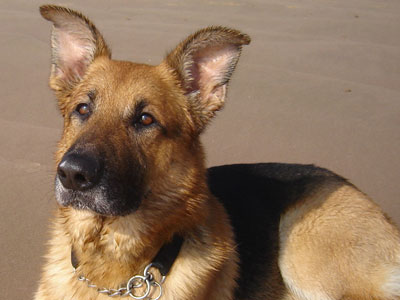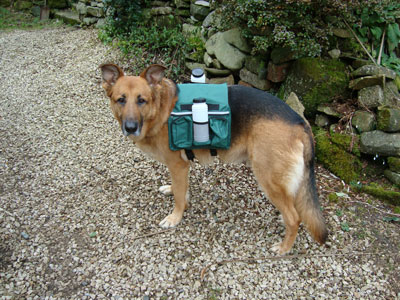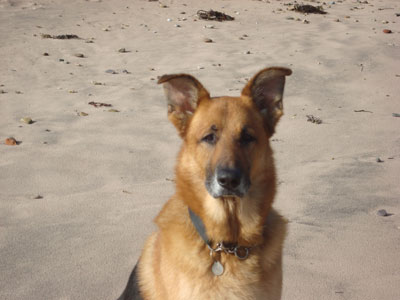In July, 2008 we adopted Kieron, a large male GSD X (3/4GSD, 1/4 Rough Collie) from Dumfries and Galloway Canine Rescue. He had been thoroughly checked over by the Charity’s vets and pronounced fit and well (although scruffy and thin). When we brought him home he settled in very quickly and soon looked better - after a bath, a good grooming and regular meals of hypo-allergenic dried dog food.
However, some weeks later he started to frantically scratch his ears and chin and tried to rub his chin whenever and wherever he could - on his paws, the carpet, his bedding (and on us!), and his whole lower jaw became very inflamed. Mr. Wheeler, his Veterinary Surgeon, tried several different creams, which didn’t have any lasting effect and it soon became clear that the problem was a lower lip pyoderma. A 5 week course of Ceporex anti-biotic was prescribed. This healed the chin and, so far, that problem has not re-occurred. He is still prone to ear infections, which respond well to the administration of Canaural drops.
Shortly after the lower lip and chin healed, in the early spring of this year, he started licking his paws and groin and scratching his armpits and legs. He developed an angry rash on his chest, groin, legs and bottom, which became worse as the spring and summer went on. He lost the hair on his groin and inner thighs. As he has regular flea and tick prevention treatment and is fed a hypo-allergenic diet, it was clear that this dermatitis was a reaction to environmental factors. His vet prescribed Medrone V (an oral glucocorticoid used to treat some allergic and inflammatory conditions). We persevered with this in varying doses for about 3 months, because it seemed initially to help. But then it became apparent that the condition was deteriorating, and so Kieron’s vet changed his medicine and prescribed Amitriptyline, an anti-depressant drug which can be used as an anti-pruritic (anti-itch) in dogs, plus 2 weeks Ceporex as large areas of his chest, groin and legs were very inflamed. The inflammation is exacerbated by chewing and scratching. Although we keep a very close eye on him most of the time, there are odd occasions when he manages to sneak off on tiptoe and have a chew and/or a scratch somewhere out of sight. This has to be stopped, because the self-inflicted damage can be quite severe.
In addition to the Amitriptyline, having tried several other individual homoeopathic remedies for the treatment of grass and pollen allergies, and Urtica cream, I have been giving him 10 pillules of Phytopet’s Dust Mite, Mixed grasses, Mixed pollen homoeopathic remedy in a clean bowl of boiled, cooled drinking water once daily. This combination of conventional and alternative therapies seems to be keeping the atopy (atopic dermatitis) under control. His skin is clear at the moment, most of the time, although his paws still get very raw looking between the toes sometimes. The easiest way to deal with that area is with Cortavance spray.
As if all that were not enough for the poor dog to contend with, he was also diagnosed with Anal Furunculosis (perianal fistulae) in June 2009. This is another chronic condition and it is progressive. The fistulae are deep ulcers that form around the anus and under the tail (sometimes progressing up it) and they are very painful. They open up and drain (causing a distinctive smell). Early signs of the condition are the dog “scooting”, and/or paying excessive attention to the anal area (chewing, licking etc). German Shepherds are prone to this condition and it is (like the atopy) thought to be triggered by an auto-immune deficiency. It can be very distressing for the animal. The low tail carriage of the GSD is considered to contribute to the condition. There are various treatments for this illness - including cyclosporine, other drugs and surgery (cryosurgery seeming to be very effective in some cases). Unfortunately, there is no cure for this and the degree of success in treatment is dependent on early diagnosis. It occurs most commonly (but not always) in middle-aged male dogs. It can affect any animal - from very young dogs to very old dogs of either gender.
We noticed first that Kieron kept jumping up and rushing around looking at his tail. He then kept trying to chew and lick the area, which had developed lots of little yellow ulcers. It was also very red and swollen. A course of Ceporex cleared the infection and Dermisol cream helped heal the open ulcers. Part of our daily routine now is to very gently clean the area twice daily with a fragrance free baby wipe. Then I apply a dollop of Sudocrem, using a finger stall (made by cutting the fingers out of disposable vinyl gloves) again very gently to the whole area, including up under the tail. Care has to be taken not to lift his tail too high or to apply pressure at any time, because the whole area is so sore. He always gets a “Crackerjack” biscuit as a reward at the end. When the ulcers flare and drain, I use Dermisol cream instead of the Sudocrem for a few days. On the rare occasions when he has diarrhoea, we go through the cleansing, creaming routine after every bowel movement.
It is also very important to ensure that the IBS that often goes with this condition is controlled. We feed Kieron his dried food moistened with about half a cupful of boiled, cooled water to moisten (not soak) it slightly and we add a teaspoonful of Lactulose to each meal to prevent constipation (unless he has diarrhoea of course). The Lactulose softens the stools slightly, so that the dog doesn’t have to strain, which also very bad for the condition and extremely painful for the dog.
Both of these conditions are chronic and likely to require continual treatment, but the sooner they are diagnosed, the better the outcome is likely to be. If you suspect that your dog may have a problem - even if it turns out to be a blocked anal gland (an easy assumption), or nothing at all wrong - it’s vital that you take your dog to his/her vet immediately. The following websites have very useful information, but please discuss the problem with your pet’s vet first.
Useful Links
Atopy:-
www.martinandcarrvets.co.uk - (Common Diseases)
www.labbies.com/atopy.htm - (Dermatologic Disorders of the Dog)
Anal Furunculosis:-
www.fairfield-vets.co.uk - ("Tess" - GSD with Anal Furunculosis)
www.peteducation.com - (Skin Conditions - Perianal Fistulas)
www.videxgsd.com - (Two articles by Trevor Turner)
www.petplanet.co.uk - (look under Vet Billboard - type in Anal Furunculosis - good advice, particularly on homoeopathic remedies etc)
By Christine



